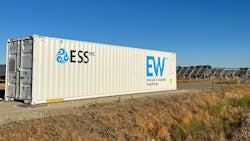U.S. Army Corps of Engineers to Test Long-Duration Energy Storage Microgrid
A new long-duration energy storage system was commissioned this week at the Contingency Basing Integration Training Evaluation Center (CBITEC) at Fort Leonard Wood, Missouri.
Called an energy warehouse, it will demonstrate how long-duration energy storage (LDES) systems, and specifically iron flow battery technology, can reduce the military’s consumption of diesel as well as improve energy resilience at contingency bases.
CBITEC is operated by the U.S. Army Corps of Engineers (USACE) Engineer Research and Development Center (ERDC), and it supports the Army by developing energy efficient and resilient solutions that address the nation’s power challenges.
The energy warehouse was delivered by ESS Tech, a manufacturer of commercial and utility-scale LDES systems, and it replaces an ESS prototype that was installed in 2016.
“This project will demonstrate the critical role of energy storage for energy security in remote and challenging locations," said Eric Dresselhuys, CEO of ESS.
LDES integrated with microgrid
ESS’ energy warehouse is a containerized long-duration energy storage system powered by iron flow batteries. LDES systems can store energy for long periods for future dispatch, often as long as eight to 12 hours, compared to shorter-duration lithium ion chemistries.
The energy warehouse was integrated into a tactical microgrid at CBITEC that is used to simulate the variety of conditions that can be encountered at contingency bases, which include forward operating bases, remote installations and temporary bases erected to provide disaster relief.
Most contingency bases today are powered by diesel generators, but transporting the fuel necessary to maintain reliable power puts military personnel at risk, especially in active combat zones.
The "technology can dramatically reduce refueling logistics requirements and has the potential to assist in the transition to renewable energy,” said Tom Decker, operational energy program manager at USACE ERDC. “We look forward to demonstrating to all service branches how incorporating an iron flow battery can increase resiliency in military power applications.”
The goal: Improve resilience and reduce diesel consumption
The demonstration is expected to prove that adding an LDES system to a contingency base microgrid can provide energy resilience, optimize the use of diesel generators and reduce diesel fuel consumption by up to 40%, according to a statement from ESS.
"Flexible, long-duration energy storage, like the ESS system, reduces total runtime on generators while increasing efficiency and allowing generators to last longer at forward operating bases," said Decker.
Other U.S. military facilities testing LDES systems
The Army Corps of Engineers is not the only U.S. military group testing the possibilities of LDES-powered microgrids. With funding from the Department of Defense’s Innovation Unit, a similar system will be installed at Stewart Air National Guard Base in Newburgh, New York.
The prototype will be installed by Ameresco and its strategic partner Redflow, a manufacturer of long-duration zinc-bromine flow batteries.








